Inside Virgin Galactic's Private Space Club
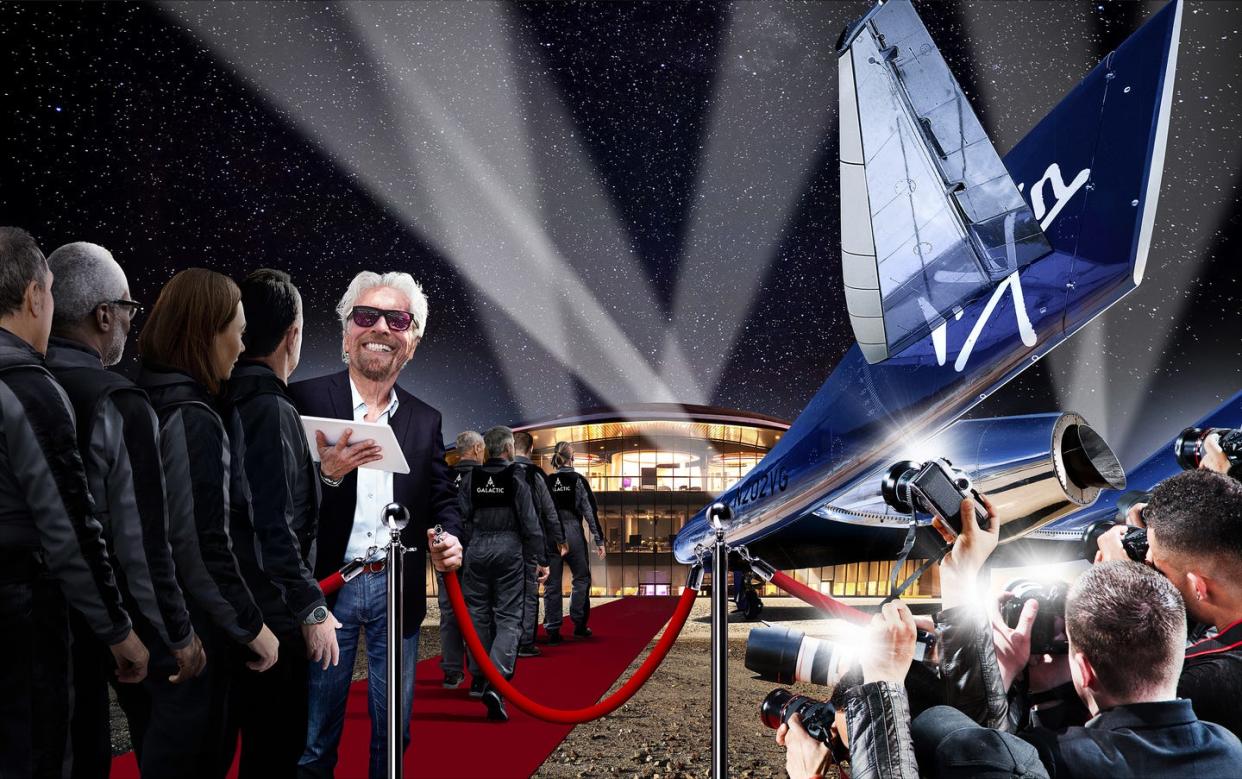
Last May I received this text message: “I know it’s been a while. We’re approaching our final space flight with our current spaceship. I thought this could be a great time for you to see the experience we’d talked about!” I had met its sender, Aleanna Crane, head of communications for Virgin Galactic, several years prior.
I read the text with some surprise. Space may be the final frontier of human knowledge, and space tourism the ultimate, rarest, and priciest of travel experiences, but for some time now there has been mucho talk and seemingly little action. Richard Branson, after all, first announced his venture nearly a quarter-century ago. Nearly 20 years later he was telling a reporter, “It would be embarrassing if someone went back over the last 13 years and wrote down all my quotes about when I thought we would be in space.”
Mid-2021, however, signaled a great leap forward. In the span of just three months, the three highest-profile billionaire players in the private space travel world had made come-fly-with-me history. Branson went to space on July 11 on Unity (she made her maiden flight in 2018, but sans civilians). Nine days later Jeff Bezos did the same, on a spaceship built by his company, Blue Origin. And a remotely piloted rocket operated by Elon Musk’s SpaceX blasted off from Florida’s Kennedy Space Center in September with four private citizens on board. (Musk himself demurred.)
There was a flurry of excitement—the new space age cometh! Heads of private offices and travel advisors with high-net-worth clients started calling, mentioning a surge of interest in space bookings. But then…crickets. That was three years ago.

The flight of VSS (Virgin Spaceship) Unity that Crane mentioned would take place on June 8. Called Galactic 07, it would be Unity’s seventh flight with paying space tourists (and its last, before the new model spaceship comes into service). I was to come for two days, so I could witness the flight (which lasts 70 minutes and takes passengers just beyond the edge of the atmosphere, 54.4 miles above Earth), hear about Virgin Galactic’s plans for future space travel, and meet some of the members of the most exclusive club on Earth: the 37 people who have already been transported to space by Virgin Galactic, as well as some of the hundreds waiting to fly, most of whom have paid in the high six figures for the adventure. “They like to come to the launches” in solidarity, I was told, and to relive a life-changing experience. “I still get shivers’,” says one of them, who went to space last May. “I now think about space every single day.”
This tight-knit group, which Virgin Galactic calls the “community” (“We all know each other”) is defined by levels of engagement. Alumni astronauts (who have flown already) and future astronauts (who have purchased their tickets but have yet to be scheduled) get access and privileges: attendance at not only launches and other Virgin Galactic events but also classes and lectures, invitations to adventurous earthbound trips, visits to Branson’s Necker Island retreat, and the like. “I’ve been to probably 70 events,” says one early adopter who bought his ticket in 2010 and flew in October 2023. “I love this community. It was almost worth the price of the ticket.” “Next generation” astronauts have paid only a nominal fee for limited access—they’re thinking about it. “I’m next gen,” is how one proudly introduced himself at the launch.
The driver who shuttles me from the airport in El Paso to Las Cruces, New Mexico, can’t contain his excitement about the upcoming launch. “Oh, you’re in for a treat, no two ways about it!” I overhear people—definitely “civilians”—at breakfast at the Hotel Encanto, where most of us associated with the June 8 flight are staying, animatedly talking space over huevos rancheros.
It’s early morning on June 7 when I set out from Las Cruces, heading 55 miles north to Spaceport America, the base of operations for Virgin Galactic and the first facility in the world designed (by Foster & Partners) chiefly to launch paying travelers into space. It announces itself subtly—first, just an earth-colored rise in the Jornada del Muerte basin of the Chihuahuan Desert, which, in the late 1500s, the conquistadors crossed on their journeys of colonization. As I draw closer, the sun rising behind the jagged Organ Mountains, the spaceport takes on the appearance of a giant moth, wings outstretched on the ground. The deep cleft between them is the dramatic entrance and exit to Virgin Galactic’s Gateway to Space for visitors and astronauts. While much else goes on here—vertical rocket launches, high-altitude drone launches—since 2019 Virgin Galactic has been the spaceport’s anchor client.
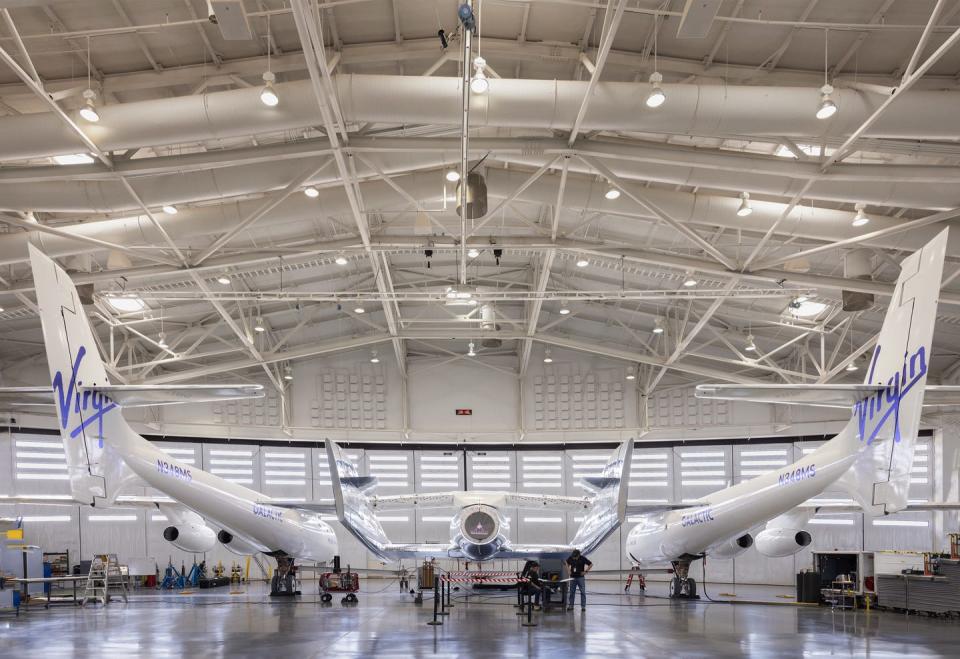
The place is abuzz, even though liftoff is still 24 hours away. The staff, including top brass, has gathered to put on a show in anticipation. As James Willoughby, formerly of Disney and now Virgin Galactic’s vice president of customer operations, tells me, “Flying to space is one thing. Developing, enriching, and educating people is another. We like to open up this place and show you what we do.”
In the vast, light-filled hangar of the spaceport, there is Unity, beautiful in its long-nosed gracefulness, and the double-fuselaged mothership Eve, which will bear Unity aloft part of the way up. “We were looking for a simple and elegant way to get to space,” says Stephen Justice, Virgin Galactic’s senior vice president of engineering (i.e., no rude vertical propulsion from Earth). I am granted access to the mission control center, which seems astoundingly complex to my untrained eye. It is vacant on preflight day (mission days start at 2:30 a.m.), and it bristles with 10 clusters of large computer screens. Each console, at which three experts sit, is dedicated to a single area of expertise and continually analyzes data pouring in.
The next stop is the flight simulator, where we see and hear visuals and audio of a typical flight. I learn that the simulator’s primary purpose is to address things that can go wrong. “See that guy over there?” asks Dave Mackay, Virgin Galactic’s chief pilot (formerly a British Royal Air Force test pilot), indicating a colleague. “He’s very devious. He doesn’t present us with just one failure but multiple failures. One to distract us, and another, and another after that. We work it hard.”
The last stop of my tour is the third-floor astronaut training center, where those about to fly spend three preflight days. On day one, they can bring their families up for a visit (as one community member told me, “They’re not flying, but they’re going on a journey too”). I’m allowed in because those on Galactic 07 tomorrow have already departed after their full-dress rehearsal. It’s sumptuously quiet and dark here, with inviting couches in the central lounge. “We were strangers, but we really bonded here,” an alum says.
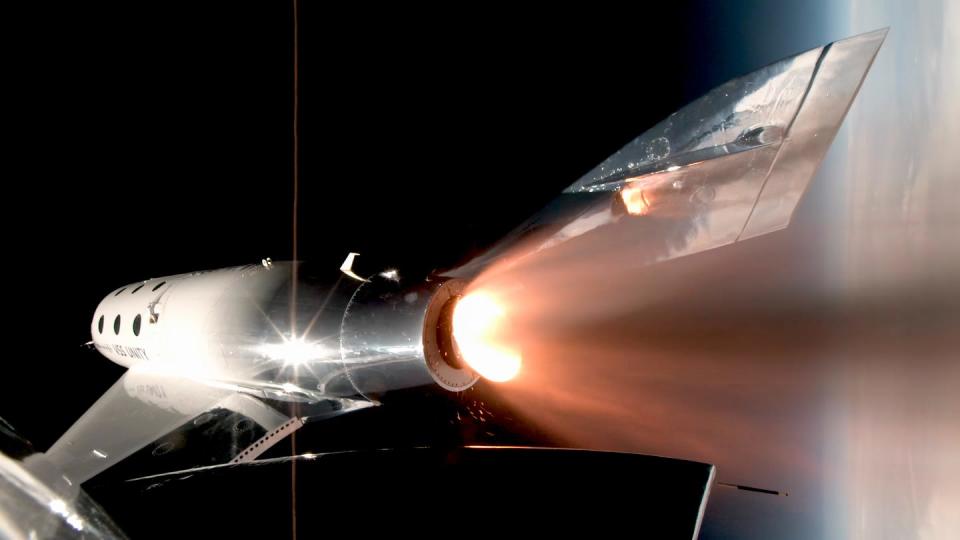
I see the training rooms and the replica of Unity’s cabin, where tomorrow’s astronauts have practiced their moves. It’s easy to imagine being one of them—that it’s my space suit hanging in my personal mirrored suite, along with my boots and base layers; that in its pockets are the things I’ve chosen to take to space. Cost aside, all this suddenly feels possible—and very desirable.
The atmosphere outside the spaceport on June 8 is electric. A crowd of around 600 is milling about—well-dressed, photo-op-ready friends and families of the voyagers, assorted visitors, members of the community. There is cheering from the assembled during the Walk of Fame, as Unity’s pilots and passengers, resplendent in black space suits with purple Virgin Galactic insignia, emerge from the training center, where they have been in seclusion all morning.
The passengers on this flight are: a New York City real estate developer of joint Israeli and American citizenship; an Italian-born, London-based hotel investment consultant; a propulsion engineer from SpaceX (for whom space flight has been a long-standing dream); and a scientist from Ankara, of Turkish and Azerbaijani heritage. The cheering intensifies as the astronauts get into Land Rovers and are driven to the runway, where Unity and the mothership await. All but the scientist have paid eye-popping money for what they’re about to experience. Back in 2013, early adopters could cop a future booking for a mere $250,000. Since then the price has risen, first to $450,000 and just recently to $600,000.
What follows is a composite of quotes and observations from the passengers and pilots describing what happens next on flight Galactic 07.
You board the spaceship cabin through its hatch door. There are six seats: four for passengers, each with its own window, two for the commander and pilot, and more windows on the ceiling. A rack in the back holds equipment for scientific experiments. You sit down, strap in, and hear the hatch close. “That makes it real. It won't open again until we've gone to space and back.”
Liftoff is a gentle slope. The mothership will bear the spaceship upward for the first phase of the journey, as if it were an airliner. You see the spaceport and runway getting smaller below you.
The release, separation from the mothership, happens 55 minutes into the flight, at an altitude of about 44,000 feet. Commercial airliners do not venture that high, because the air is too thin. Rocket fuel stored in the rear of the spaceship will propel you the rest of the way, beyond the atmosphere into suborbital space. “You’re under high adrenaline.”
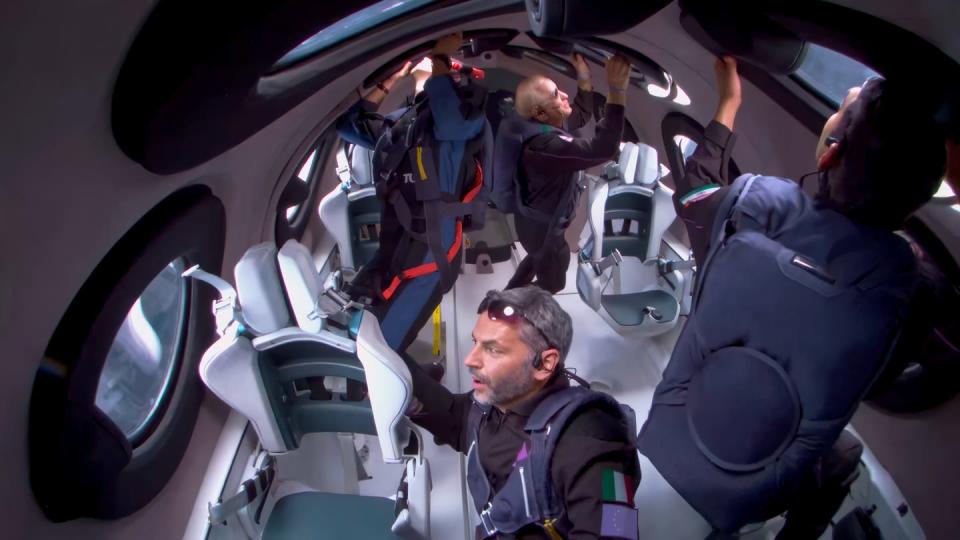
“Release! Release! Release!” the commander and pilot order. There’s a loud mechanical noise, then silence. The mothership and its jet engines are now above you and veering leftward and away, starting the descent back to Earth. For precisely four seconds, the countdown to rocket ignition, the spaceship falls. “I could see my cabinmate’s hair, in front of me, just going up.”
Boom! The pilot starts the rocket motor. The so-called “boost” into outer space begins. There’s momentary forward propulsion, then the gamma turn, as the pilot points the nose of the vessel straight upward. “Within eight to 10 seconds, you’re traveling vertically at supersonic speed: Mach 3, three times the speed of sound, with, eventually, 4 Gs of acceleration pressing down on your chest.” “The onset of pressure is not uncomfortable. Then it’s the most pressure you’ve ever felt. But you can withstand it. And you’ve prepped for it during training.” You remain that way for the next 50 seconds, "in your seat but on your back, rocketing up and out of the atmosphere, watching the sky go from blue to purple to black."
“The boost! My god, the boost!” Everyone is smiling. “It is so exciting. You think you’re ready for this, but you’re shocked when it actually happens… I hear a fellow passenger gasp, then I realize it’s a cheer of joy, and he keeps at it for 10 seconds.”
You are now at the edge of the atmosphere, 287,000 feet (54 miles) above Earth. The motor shuts off. “The sun is very bright, but all around is the deepest black. Our brains are not used to this.” And the silence is deafening. “I could hear the rubber of my crewmates’ shoes touching their seats.” You’re in microgravity; even though the ship is still ascending, you are weightless inside it and free, for next three to four minutes, to unstrap. “You gently touch your seat and start floating up.” And around. “I saw one of my cabinmates upside down. Or maybe I was upside down. I don’t know.”
“You see Earth, its colors—the blues, greens, browns, yellows. They’re magnificently bright, as you’ve never seen them, because there is nothing up here, no vapor, no dust particles. Nothing is attenuated. Space, by contrast, is the darkest, densest matte black you’ve ever seen. And separating the two is this very beautiful but very thin band: the atmosphere, its relative thickness like that of an apple skin to an apple. You think, That’s what’s keeping everything on planet Earth alive.”
The pilot flips the spaceship upside down (in microgravity you don’t feel it), and the ceiling becomes the floor. You’re on a glass-bottom boat in space. Three minutes in, you hit apogee—the highest point above Earth the spaceship can go on its rocket fuel. “You are at zero speed now, hanging for a moment motionless in space right above Earth. Then gravity starts to drag the ship back down.” But you are still weightless. Thirty seconds more, and the pilots tell you to return to your seat and strap back in.
The pilots right the ship and prepare it for reentry, turning it, in effect, into a glider, its wings “feathering,” the “feathers” both slowing and stabilizing the descent. “You hear air molecules slamming into the outside of the vehicle, rapidly building to what sounds like a waterfall. The noise is louder than the rocket boost. It rattles the walls. You’re sitting comfortably, but it’s a visceral, dynamic experience.” Ten minutes later you’re turning ever tighter circles over the runway, then landing smoothly right where you took off.
The mood after landing is celebratory. Virgin Galactic’s CEO, Michael Colglazier, is on hand: “Most people only get to read about history. It’s super-rare to be part of an exclusive group that is actually making history. Let’s party tonight, and then go and build a spaceline!”
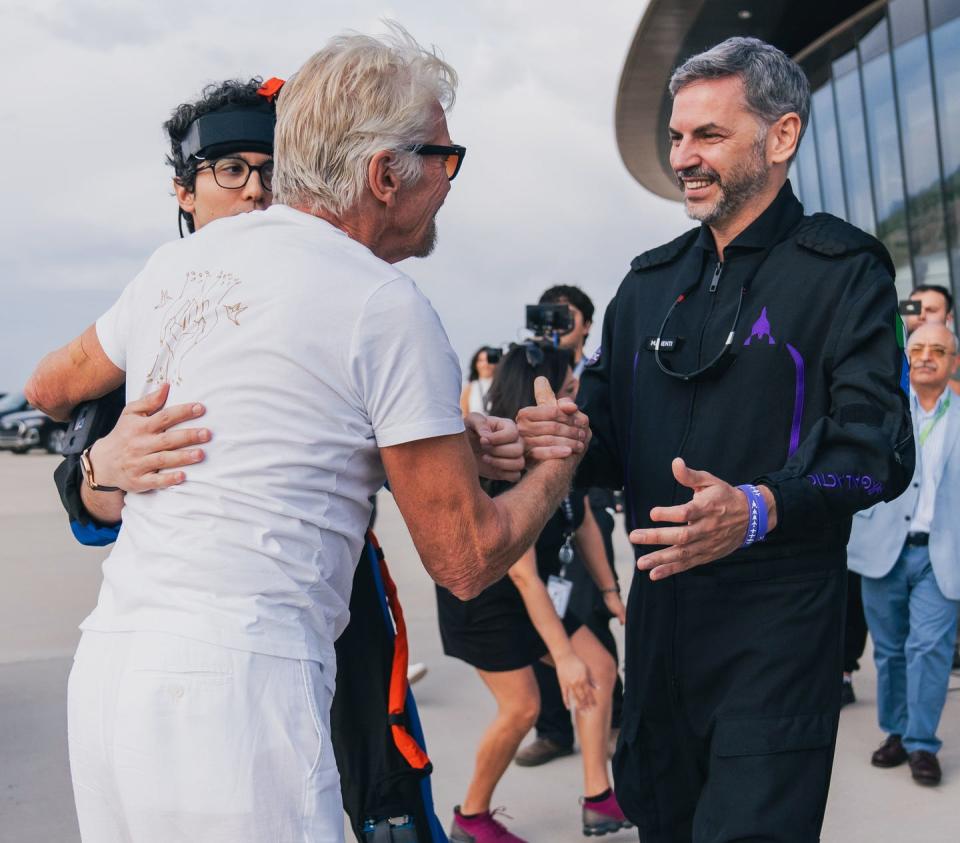
Easier said than done. Now that Virgin Galactic has proven that it can take people safely to space and back, it faces a supply-and-demand problem. As Mike Moses, a former director of NASA’s space shuttle program and Virgin Galactic’s spaceline president, says, “There are currently more than 700 people in our pipeline, across 60 countries,” meaning people who have purchased tickets and are waiting to be assigned a flight date. “Our problem is not technical, it’s economic.” That’s why Virgin Galactic is devoting all its resources to developing new Delta class ships; there will be two initially, four eventually. Test flights will begin in 2025, commercial flights in 2026. Unity can take only four passengers at a time, plus two pilots. Delta will carry six passengers. Unity can fly once a month. Delta, because it will be built with parts requiring less time-consuming maintenance, will fly twice a week. Moses does the math: “So that’s about 125 flights a year. Which is about 750 people a year—more people in year 1 than have ever gone to space.” (That number, the running total since Yuri Gagarin orbited Earth in 1961, stands at 700, including the 37 who have flown on Virgin Galactic.) “And that,” Moses emphasizes, “is the start of a spaceline. One chapter is closing, and the next one will be huge.” (If projections pan out, that is. Virgin Galactic recorded a net loss of $94 million for the second quarter of 2024.)
Stephen Justice insists: “Look, getting to space is difficult. Not many get to go. In the early 1900s the only people who went up in airplanes were either daredevils or the really rich. They were the only ones able to take a ride. Now almost everybody can get on an airliner and fly somewhere in their slippers and pajamas. But you have to take those first steps. Which is what we’re doing here now: taking those first steps toward making space so normal and ordinary you don’t even think about it.”
Branson is there too. “Others have aims of going to Mars,” he says, “which is absolutely extraordinary. But what we want to do is enable many people to experience what our astronauts experienced today.”
There is more to applaud here than what is surely the world’s greatest joyride, it struck me amid the brouhaha: something that transcends consumercentric space travel. This flight was also an international research mission. The rack behind the passenger seats held gear for experiments being remotely conducted by UC Berkeley and Purdue, arranged by NASA. The Turkish scientist wore beneath his space suit monitors from Harvard Medical School and Mass General Hospital measuring, among the other effects of weightlessness, the impact on his cerebral cortex of the “overview effect”—the complex of emotions produced by seeing Earth from space.
“This is part of a new era of access to space for the science community,” says Kellie Gerardi, a researcher at the International Institute for Astronautical Sciences, who flew on Galactic 05 in 2023. “I was only number 677 in space. We are only at the beginning of even knowing what questions to ask. Repeated access to microgravity is critical.” Without the hard-won knowledge enabled in part by the patronage of Virgin Galactic’s community—by their space flights—we might as well kiss those dreams of Mars goodbye.
Bookings reopen in 2025, when the Delta spaceship begins test flights.
This story appears in the October 2024 issue of Town & Country. SUBSCRIBE NOW
You Might Also Like


